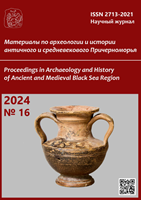Кольчатое наголовье второй половины XVI — середины XIX вв. из собрания Национального музея Республики Казахстан
Mail coif of the second half of the 16th — mid 19th centuries from the collection of the National Museum of the Republic of Kazakhstan
Author(s): Leonid Bobrov, O.M. Agatay, Syrym Serikkazinovich KhasenovSubject(s): Cultural history, Museology & Heritage Studies, Archiving, Social history, 16th Century, 17th Century, 18th Century, 19th Century
Published by: Нижневартовский государственный университет
Keywords: history of Kazakhstan; Kazakh Khanate; kazakhs; ring mail coif; chainmail hood; ringed “bashlyk” (mail coif);
Summary/Abstract: The article analyses a unique mail coif (ҚРҰМ нқ ҚЖ 13) stored in the National Museum of the Republic of Kazakhstan. Based on its design features, the mail coif is attributed as one of the variants of ringed “bashlyks”. The closest analogues were found from the territory of Central Asia and Southern Siberia. In Kazakhstan and Maverannahr (in particular, in Kokand) the mail “bashlyks” were used until the middle ofthe 19th century. The model is unique because the production of crown used flat “baydana” rings. The late period of the spread of ringed “bashlyks” with a “baydana” crown in the region was previously localized in the second half of the 16th — early 17th centuries, that is, the period of the existence of the Kazakh Khanate. It is likely that the mail coif of the National Museum of the Republic of Kazakhstan was made in the 17th— 18th centuries by craftsmen of Maverannahr or neighboring territories and was in service with Kazakh, Uzbek or, less likely, Oirat (Dzungarian) warriors. The artifact is a vivid model of Central Asian mail coifs and is a vivid example of the military-cultural relations of the Kazakhs with the Bukhara Khanate, Kokand and other state entities of the region.
Journal: Материалы по археологии и истории античного и средневекового Причерноморья
- Issue Year: 2024
- Issue No: 16
- Page Range: 670-685
- Page Count: 16
- Language: Russian

